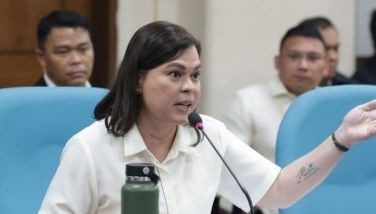MAP rolls out innovative approaches to curtail classroom deficit
MANILA, Philippines -
FACT:
The number of classrooms cannot keep up with an ever-increasing demand for it. Even if the Department of Education (DepEd) compounds its budget for classroom construction every year, the number of enrollees in public schools keeps outpacing the growth in the number of classrooms.
Former Education Secretary and Management Association of the Philippines (MAP) Education Task Force chairman Jesli Lapus, this quandary is not without solution. He then drafted a proposal paper identifying viable measures on how to slash off a significant amount in the current classroom deficit which he, along with other MAP members, presented to President Benigno Aquino Jr. through a letter.
“It can be done,” he stated in his paper. “This is the right time to wage the decisive battle against the nagging classrooms shortage problem. There is a government that enjoys the unprecedented popularity to wield the necessary political will. And there is a financial system that enjoys unprecedented excess liquidity eager to invest in the future of the country.”
The compounding problem
For this year, DepEd is allocating only P8 billion for the construction of 10, 000 new classrooms. At first glance the number looks ample enough. But considering that the population jacks up by an estimated 2.04 percent or 1.9 million persons annually, the number of available schoolrooms will still pale compared to the number of students.
Moreover there are additional factors that exacerbate the problem and these are: (1) The implementation of K+12 program which adds three more year levels to the present basic education cycle of 10 years; (2) The government’s campaign for higher participation and lower dropout rates; (3) Thousands of badly dilapidated and unserviceable classrooms; and (4) The constant destruction of classrooms by typhoons, floods, landslides and other natural calamities.
Based on the estimated annual growth and the additional factors, Lapus computed the projected classroom demand from 2011 to 2016 at roughly 124,000 units. “The annual classroom shortage for the next five years ranges between 94,000 to 124,000 units which requires more than P72 to P99 billion a year at the average cost of P800,000 per classroom,” he said in the report.
“Certainly, this requirement dwarfs the peak budget allocation of P8 billion in 2011,” he adds.
Ingenious, practical solutions
The proposal paper tendered a number of actions that “will allow Philippine basic education to dramatically catch up with the burgeoning demand for new classrooms.” These approaches include:
(1) Adopting a more flexible government education budget (GAA). Under the 2011 DepEd Budget, a total of P12 B was allocated for school facilities, of which P8.3B is appropriated to finance new classrooms. If the traditional approach of pure capital outlay will be utilized, the government will generate merely 10,000 classrooms or 20,000 in two years. Not enough. By introducing the “rent-to-own” Maintenance Operations and Other Expenditure (MOOE) option in the General Appropriations Act (GAA), the same budget amount can generate more classrooms than if this amount were spent to build (capital outlay).
Under this approach is the Public-Private Partnership (PPP) option where the government partners with the private sector (i.e. banks) to frontload classroom construction. Its benefits include minimizing opportunities for government corruption and providing the market with business opportunities. The PPP option lists two possible schemes: Rent-to-Own and Turnkey schemes.
(2) Priority Development Assistance Fund (PDAF). Pork barrel can be another source of funding. If at least 30 percent of the annual pork barrel (Congressmen - P70 million and Senators - P200 million) is allocated to classroom construction in the next two years, it will deliver 19,000 to the education system.
(3) Special Education Fund (SEF). SEF can be utilized as loan collateral with financial institutions in order to frontload the financing of school buildings. A portion of the SEF can be earmarked as annual debt service with a corresponding annual interest.
(4) Development assistance. International development institutions are always keen on supporting projects that aim to improve school facilities and services.
(5) Donations and aid. Donations from the private sector and civil society organizations both local and abroad will help sustain these efforts. Organizations like Philippine Business for Social Progress, Fil-Chinese Chamber of Commerce; agencies USAID, AUSAID, UNICEF, Spain and other foreign donors have contributed generously to the cause.
Lapus clarifies that some of the recommendations are not entirely new. “Some have been presented to Congress, to Cabinet, to the League of Provincial Governors and discussed in PPP workshops on various occasions in the past,” he disclosed. Although received favorably, he has yet to see “concerted and determined implementation in its entirety,” actually done.
In the letter to the Chief Executive signed by Lapus and current MAP president Felino Palafox Jr., MAP is extending their assistance in realizing the proposed schemes by calling for active participation among the members of the organization. They also vowed to lobby with the legislators and local government units to support the President.
For detailed contents of the position paper, log on to www.map.org.ph.
- Latest






























